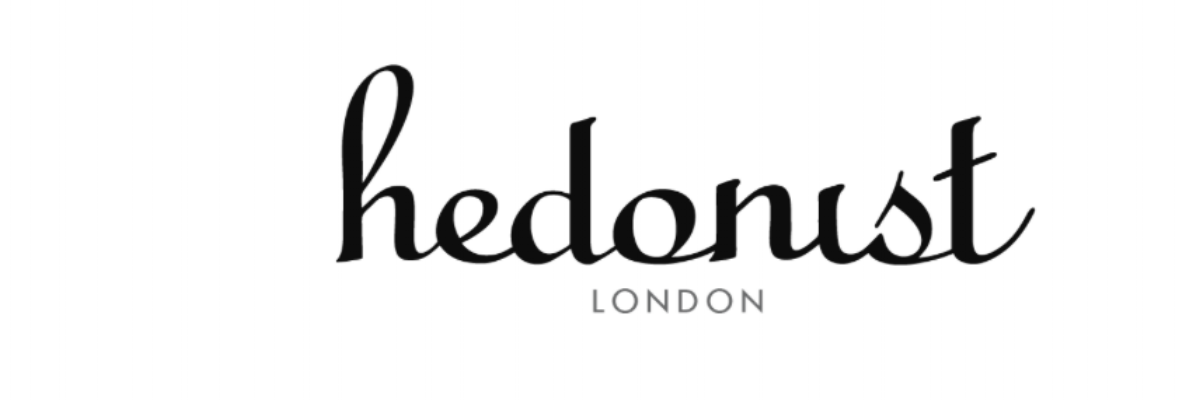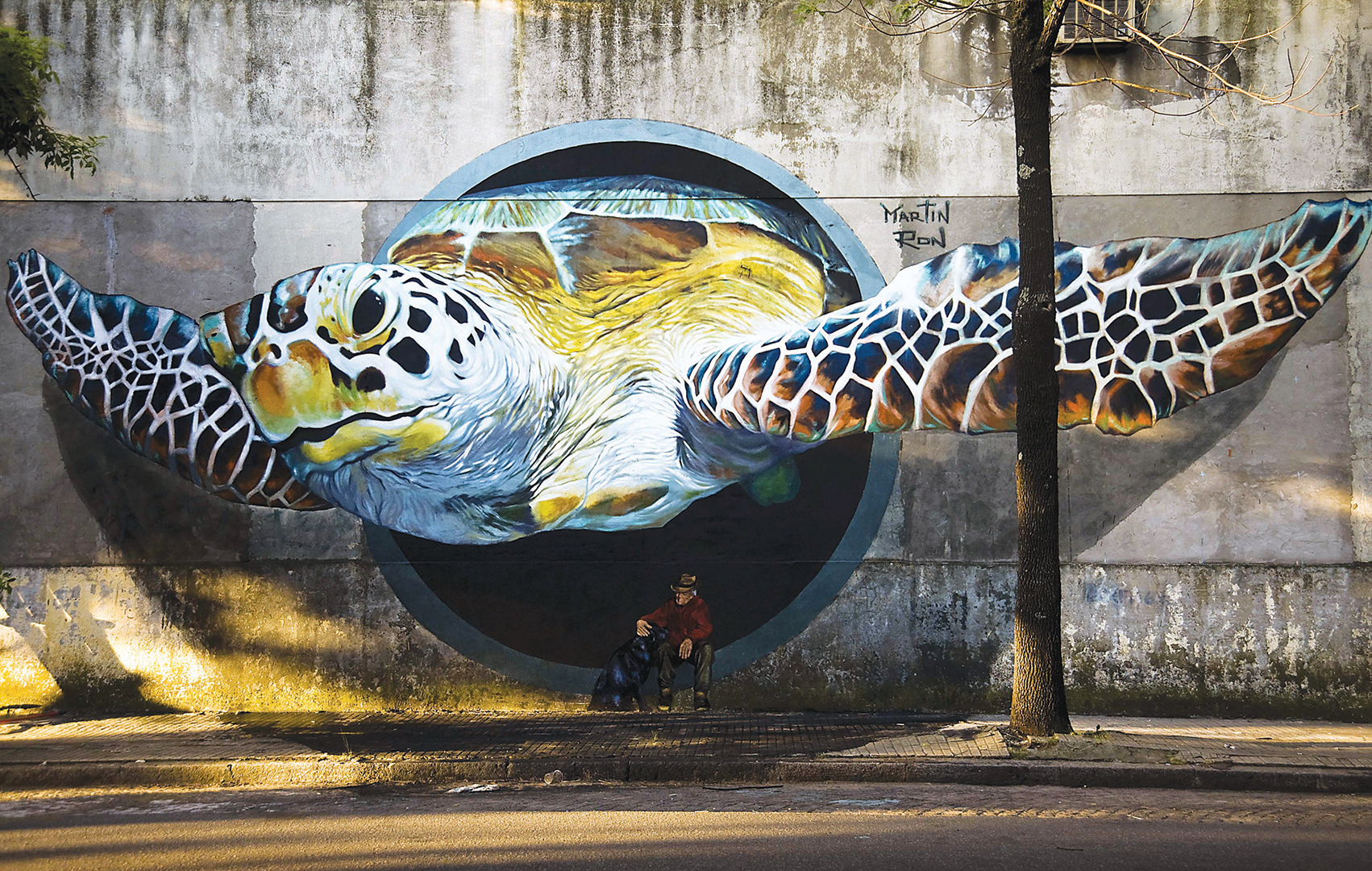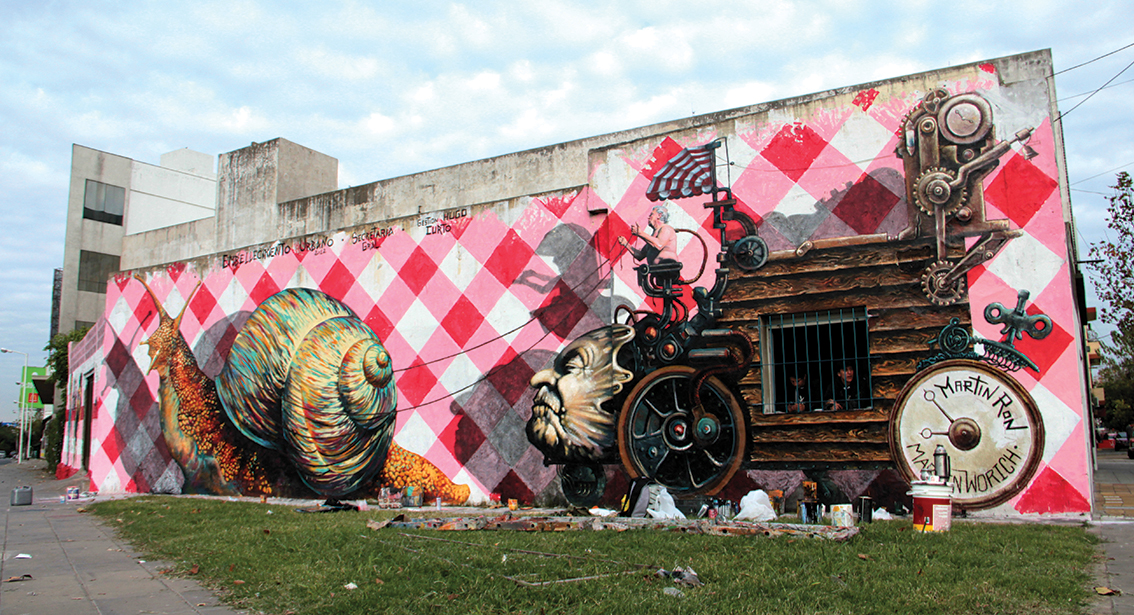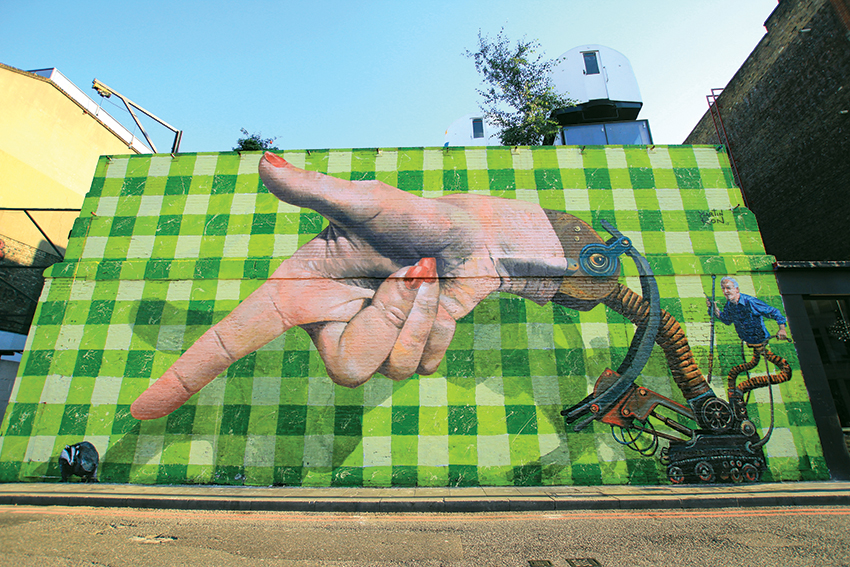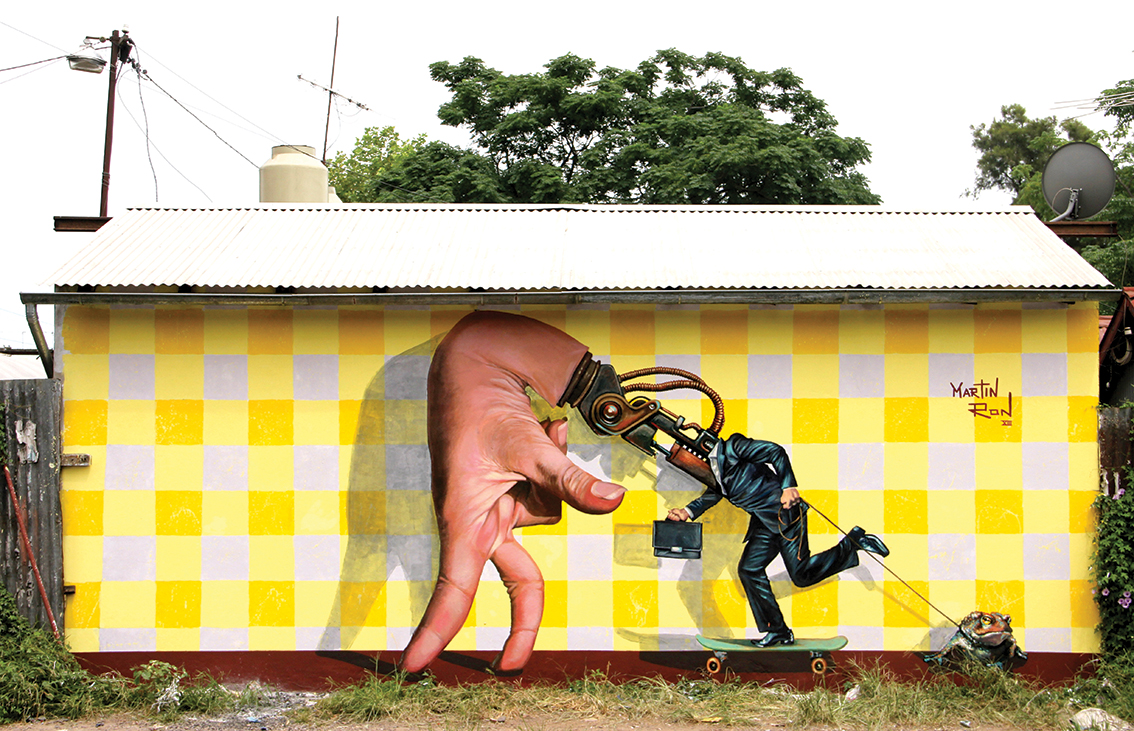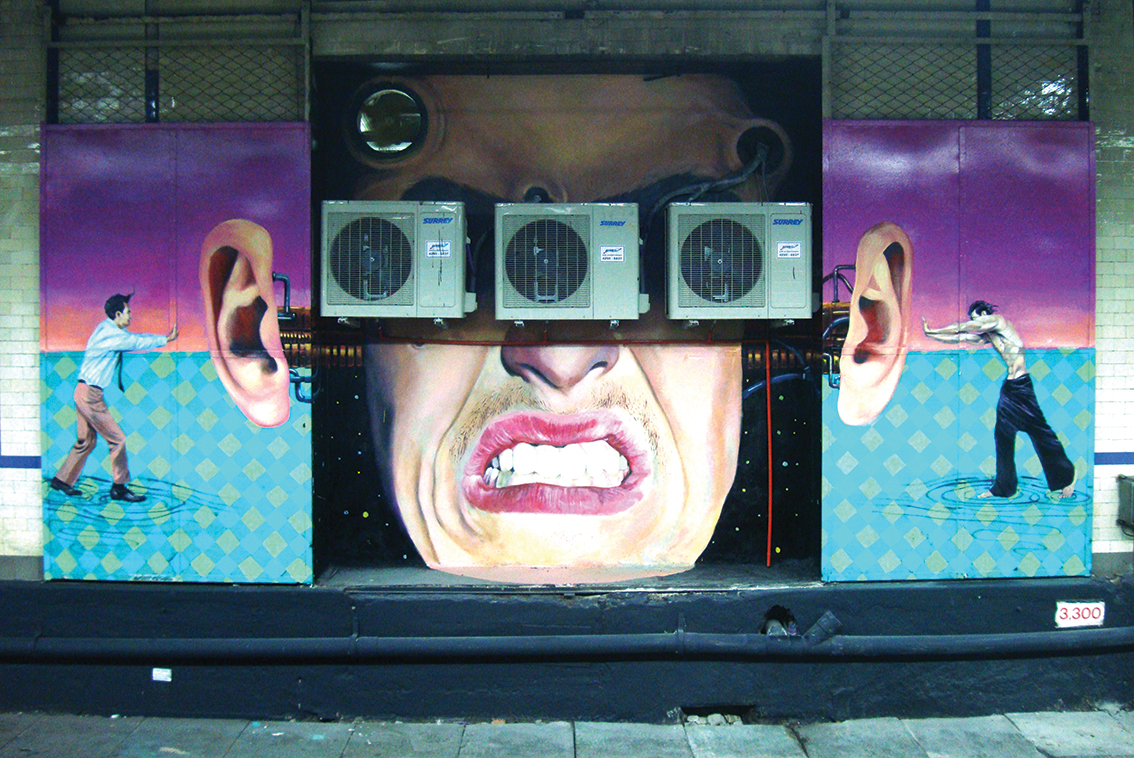interview with Argentine street artist Martin Ron
Words by Verónica Gómez, Photos by BA Street Art and Miguel Babjaczuk (buenosairesstreetart.com)
Martin Ron has painted some stunning murals on a huge scale mixing together surreal elements and everyday occurrences. “What I like most about painting is generating situations of fantasy that have a lot of 3-D so that the technique can be so hyper-real that it generates imaginary situations that appear to exist,” says Martin. “I like it so that the mural comes out of the wall and co-exists with other situations.” A 3-D sea turtle exploding out of a pipe, a giant skateboard carrying a sculpture of a boy listening to talking parrots, a snail pulling along an old cart by a busy motorway, and a Queen´s guard performing the capoeira are some of the fantastic creations by the Argentine street artist.
Martin, 32, grew up in the town of Caseros in Buenos Aires and aged seven his mother enrolled him in a painting workshop. “I didn´t wake up one day thinking I want to be a street artist, I have always loved art,” he said. “From the age of 10 I was painting with oils and the first mural I painted was a skull in my bedroom, my friends really liked it and then asked me to paint their bedrooms, and I was then invited to paint a mural in my school.”
One of his best known murals is that of a sea turtle coming out of a hole in the side of a factory wall painted at the Meeting of Styles street art festival in Buenos Aires 2012. The artwork took him four days using latex paint applied with brushes and rollers. In many of Martin´s artworks he uses figures on a human scale to exaggerate the effect of 3-D. “The turtle is beautiful animal that isn´t seen a lot. It also has a lot of colours and textures and I thought it would be really interesting to paint. Each person can feel free to interpret the mural how they like. Perhaps my intention was to personify the imagination or the spiritual part of the person in the form of a turtle and a hole in the wall from which his imagination flies out,” revealed Martin. “The old man is not only a way of increasing the effect of 3-D but is an intricate part of the story that is told on the wall.”
Martin´s biggest mural to date measures 412 square metres and is one of the biggest in the city of Buenos Aires. Named “The Parrots’ Tale”, covering the façade of a four storey building, the artwork took him 16 days with the help of two assistants. The mural project was organised and managed by the organisation BA Street Art that promotes the street art scene in the Argentine capital, and the city government paid for a crane, two assistants and 60 litres of latex paint.
The mural features an enormous skateboard carrying a statue of a boy inspired by French sculptor Jean-Baptiste Carpeaux, and other surreal elements include a huge hand holding a lollipop stick with a wasp spinning a record. Friends and family, neighbours or passers-by often appear in Martin’s murals. Gabriel Dotta, a friend of Martin´s, is the figure with his tongue sticking out and an aeroplane lifting him up by his hair, and the hand is modelled on that of his girlfriend Erica. “Martin often immortalizes people he knows in his artworks,” explains Gabriel. “Martin told me that I have a really interesting face to paint so to include me in one of his murals is a great honour. For me Martin is the Messiah of murals.”
Another surreal mural named “Il Carromato Superstar” by a motorway in the Province of Buenos Aires, features Martin’s uncle Rodolfo driving a rickety old cart being pulled by a snail. The artwork provides a moment of light entertainment for watching motorists stuck in traffic jams on their way to work.
Improvisation is a strong feature of Martin’s work. “I like to think ´live´ while I am working,” he explains. “On paper I think about painting a certain situation but then I look at the wall again other ideas emerge and with people, animals and objects interacting with the space, the mural carries on mutating. I have an overall concept for the mural at the start and a general idea what it’s going to look like but when it’s finished it often looks very different as the composition has changed and I have added more details or elements.”
In August and September, Martin was in London and painted two surreal murals in Shoreditch. The first on the Village Underground wall depicts a giant mechanical hand pulling the trigger at a cowering badger. The artist only came up with the concept for the design after seeing a TV news report about the badger cull while staying with a friend in London. It took him a week using gloss paint and the mural is entitled ‘David versus Goliath’. “I think the cull is a mistake,” says Martin. “I thought a mural about it would be good to create awareness about the issue. What the mural represents is a complex, powerful mutant machine without feeling (David Cameron) up against a tiny animal called the badger (Goliath) that is adapting to the world around it.” “The Magician” in Buenos Aires with a mechanical hand pulling a zip from which spring forth hundreds of rabbits.
Anumber of Martin’s recent murals have featured machines and mechanical hands. “The murals are about man and the machine and the system trying to control the world around it, then it becomes too much and starts to break down,” he explains. “I like to sometimes mix men and machines in my art to try to generate everyday situations between the complex and simple. Quite often it’s the simple things that usually work the best.” Another of his murals in Buenos Aires next to a busy railway crossing is entitled ‘Frog Going the Wrong Way’. It depicts a mutant in a suit on a skateboard carrying a briefcase on his way to work. “The idea was to combine some fun elements in an ironic way. A lot of people are in a hurry, coming and going and are in a bad mood trying to follow orders. So this little frog is asserting itself, it wants to go in another direction when things start to change and become chaotic and mechanical.” Mural mocking a stressed businessman in a hurry.
Martin also paints canvases with oils but creating murals is what he enjoys most. “What is different about painting in the street is that from the moment you arrive the public are watching,” he says. “It’s fascinating to me because people see everything that is going on until you have finished the mural. You are not producing an artwork indoors in your studio that nobody sees until it is hung on the wall of a gallery.” Hundreds of people watched Martin painting in London. “Many of the people not only see you painting but they see the whole process and others see parts of it. The comments from motorists or pedestrians always surprise me as they tell you exactly what they think. Usually they say nice things but you never can be too sure. I try to make the message about what is happening in a mural subtle so that the imagination of different people can interpret it in different ways and this in one of the things that interests me most.”
The second mural Martin painted in Shoreditch is along Hanbury Street just off Brick Lane and took him three days. It features a Queen’s guard at Buckingham Palace taking a timeout to performing the Brazilian martial art ‘capoeira’. Martin named the artwork ‘Happy Hour’. “I look at the Queen’s guards as typically English, very formal and stoic on duty wearing their uniforms and bearskins outside the palace. So I wanted to create something fun on a grand scale using this image and combining it with something typically Latin American like the capoeira. Also being British summertime with the warm weather and sunshine, this character is all about taking a few minutes to relax and also explode!”
Martin said he was overwhelmed by the reactions of passers-by and local residents while he was painting.“It was incredible,” he recalls. “People were asking for autographs, to do a sketch in their notebook or have their photograph taken with me, and one couple said they had travelled hundreds of miles to Shoreditch just to check out the street art.” He added: “The scene in London is different to Buenos Aires. In Buenos Aires, it’s a little more relaxed, there are lots of artists painting all over the city and there are lots of big walls to paint. The freedom and the acceptance of the public means that in Buenos Aires, street art is not perceived as vandalism as in some other cities and artists can take their own time creating their artworks so their designs are often of very good quality.”
So how does Martin paint murals on such a large scale? “In my case I work with photos and create a small grid dividing the image up into various blocks so I can reproduce it to scale on the wall, and with more time and experience you can recreate the image more accurately and make it bigger and bigger. When painting a large mural you need to get down from the crane and then look at the wall from a distance to check that everything is ok and then go back up again and carry on painting and do it over and over. With more experience your technique improves so that you don´t need to go up and down on the crane quite so much and there comes a point where you are almost painting blind. The reality is that sometimes the mural is so big that you are painting just one metre from the wall and you don´t see the whole picture but the more you paint the faster you become and the less you need to stand back and take a look all the time.”
Martin has also taken part in a number of public art projects including painting murals in several metro stations in Buenos Aires and the first project in Latin America to make installations on metro carriages. He has just finished painting a big mural in Plaza Miserere station with part of the design including a machine-like portrait of his friend Juan with his eyes made up of air-conditioning units. The whole mural took Martin with the help of two assistants eight nights to complete as during the day the station operated a regular metro service. “The project is all linked improving the quality of life of people in the city of Buenos Aires through urban art,” explained Martin. “The metro stations are spaces with a lot of traffic and often they are depressing and dark, so a little bit of colour can be enough to bring a smile to the face of the commuter and make their journey a little more enjoyable.”
Martin Ron is not the only street artist painting giant murals in Buenos Aires. Alfredo Segatori, affectionately known as ‘Pelado’ has been working on what is thought to be the biggest mural painted by a single artist in Argentina. The enormous artwork on the banks of the Riachuelo river measures around 1300m2 (100m long x 13m high) and is called ‘The Return of Quinquela’ featuring a portrait of Argentine painter Benito Quinquela Martin who is famous for painting dockyard scenes in the old port area of Buenos Aires. It took Alfredo two months to paint using predominantly aerosol spray.
I thought it would be interesting to do a portrait of Quinquela as he is a symbol of the place, and also I wanted to recreate the real people who live in the vicinity,” explained Alfredo. “The neighbours really liked the idea and have promised to look after the artwork.” The mural is a public art project organised by the city government as part of a plan to improve a rundown area near the Riachuelo in the south-east part of the city.
In Buenos Aires, every weekend it is common to see street artists and graffiti artists painting and often they get permission from local residents and business owners to decorate the fronts of their houses and shops. Unlike some other cities, an artist does not need permission from the local authority to change the appearance of a building, only the permission of the property owner. As long as the artist doesn´t paint anything that might offend the neighbours, he or she is then free to paint what they like.
Luciano Gatti known as ‘Ice’, who is well known for his designs around the city featuring animals and mushrooms, finished a new mural in the neighbourhood of Villa Urquiza (in November 2013) that covers three sides of a house and features a samurai fighting scene. Alberto, the owner of the property, was more than happy to let Ice paint what he wanted and local aerosol company Kuwait even paid for all the materials. “I often work with images I find on the internet,” revealed Ice. “I came across some samurai warriors and with all their armour I thought they would be cool to paint.” He added: “A policeman did pass by and ask me if I had permission to paint the wall, I told him ‘yes’ and he said that he really liked the mural.”
